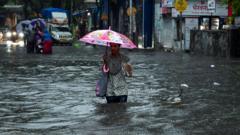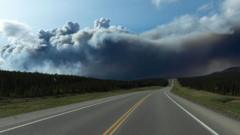With the looming Australian election, PM Anthony Albanese confronts mounting challenges, from climate crises to economic woes, all while competing against a reinvigorated Peter Dutton and a rising tide of independent voices.
Albanese Struggles as Australian Election Looms

Albanese Struggles as Australian Election Looms
The Prime Minister's agenda faces turbulence amidst natural disasters and rising scrutiny.
As Australia prepares for its upcoming election on May 3, Prime Minister Anthony Albanese is battling significant headwinds that threaten his bid for a second term. His government has faced numerous challenges, starting with the recent devastation caused by Cyclone Alfred along the east coast, which prompted a shift away from the intended election roadmap just as he was set to announce polling details.
Albanese's leadership has been synonymous with promises on climate action, addressing the cost-of-living crisis, and tackling Indigenous issues, particularly the proposed referendum for an Indigenous Voice to Parliament. However, that latter proposal met a significant setback when over 60% of voters rejected it, leaving Albanese in a precarious position as he grapples with growing public discontent.
The political landscape has tightened, with leaders from the opposition, particularly Peter Dutton of the Liberal Party, positioning themselves advantageously by focusing on Albanese's perceived failures. Dutton's previous unpopularity has shifted, and with the expected rise of independents and minor parties, the upcoming election could lead to a hung parliament.
Albanese secured victory in 2022 with a message of renewal, but economic conditions have since worsened. Interest rates have surged while inflation and a housing crisis continue to dominate headlines, complicating his efforts to reassure the electorate. Political experts suggest that despite dissatisfaction with Labor, it may not automatically translate to support for Dutton's Coalition.
As Australians head into the polls, voter participation remains one of the highest globally, aided by mandatory voting which encourages broader engagement across demographics. Although the political climate mirrors global trends of disenchantment with established parties, Australia’s electoral structure—featuring preferential voting—maintains a degree of stability against radical shifts.
While Albanese's response to recent disasters has provided some political breathing room, latest polls hint at a possible pathway for Dutton’s administration. The stakes are high, as no government has secured a second term since 1931, and the upcoming election poses critical questions about the viability of both major parties in Australia—signifying a pivotal moment in the country's evolving political narrative.




















